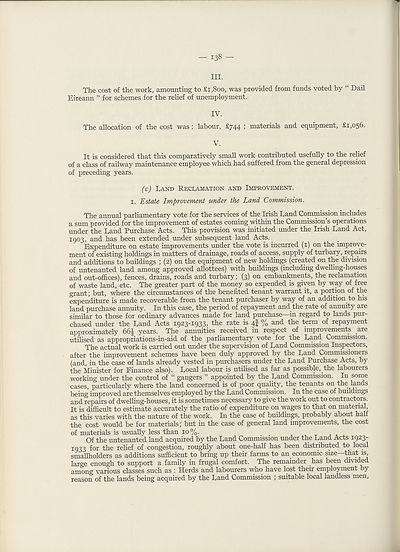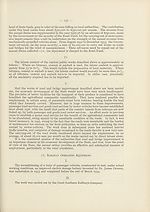Download files
Complete book:
Individual page:
Thumbnail gallery: Grid view | List view

- 138
III.
The cost of the work, amounting to £1,800, was provided from funds voted by “ Dail
Eireann ” for schemes for the relief of unemployment.
IV.
The allocation of the cost was : labour, £744 ; materials and equipment, £1,056.
V.
It is considered that this comparatively small work contributed usefully to the relief
of a class of railway maintenance employee which had suffered from the general depression
of preceding years.
(c) Land Reclamation and Improvement.
1. Estate Improvement under the Land Commission.
The annual parliamentary vote for the services of the Irish hand Commission includes
a sum provided for the improvement of estates coming within the Commission’s operations
under the hand Purchase Acts. This provision was initiated under the Irish Land Act,
1903, and has been extended under subsequent land Acts.
Expenditure on estate improvements under the vote is incurred (1) on the improve¬
ment of existing holdings in matters of drainage, roads of access, supply of turbary, repairs
and additions to buildings ; (2) on the equipment of new holdings (created on the division
of untenanted land among approved allottees) with buildings (including dwelling-houses
and out-offices), fences, drains, roads and turbary; (3) on embankments, the reclamation
of waste land, etc. The greater part of the money so expended is given by way of free
grant; but, where the circumstances of the benefited tenant warrant it, a portion of the
expenditure is made recoverable from the tenant purchaser by way of an addition to his
land purchase annuity. In this case, the period of repayment and the rate of annuity are
similar to those for ordinary advances made for land purchase—in regard to lands pur¬
chased under the Eand Acts 1923-1933, the rate is 4f % and the term of repayment
approximately 66| years. The annuities received in respect of improvements are
utilised as appropriations-in-aid of the parliamentary vote for the Land Commission.
The actual work is carried out under the supervision of Eand Commission Inspectors,
after the improvement schemes have been duly approved by the Eand Commissioners
(and, in the case of lands already vested in purchasers under the Eand Purchase Acts, by
the Minister for Finance also). Eocal labour is utilised as far as possible, the labourers
working under the control of “ gangers ” appointed by the Eand Commission. In some
cases, particularly where the land concerned is of poor quality, the tenants on the lands
being improved are themselves employed by the Eand Commission. In the case of buildings
and repairs of dwelling-houses, it is sometimes necessary to give the work out to contractors.
It is difficult to estimate accurately the ratio of expenditure on wages to that on material,
as this varies with the nature of the work. In the case of buildings, probably about half
the cost would be for materials; but in the case of general land improvements, the cost
of materials is usually less than 10%.
Of the untenanted land acquired by the Eand Commission under the Eand Acts 1923"
1933 for the relief of congestion, roughly about one-half has been distributed to local
smallholders as additions sufficient to bring up their farms to an economic size—that is
large enough to support a family in frugal comfort. The remainder has been divided
among various classes such as : Herds and labourers who have lost their employment by
reason of the lands being acquired by the Eand Commission ; suitable local landless men,
III.
The cost of the work, amounting to £1,800, was provided from funds voted by “ Dail
Eireann ” for schemes for the relief of unemployment.
IV.
The allocation of the cost was : labour, £744 ; materials and equipment, £1,056.
V.
It is considered that this comparatively small work contributed usefully to the relief
of a class of railway maintenance employee which had suffered from the general depression
of preceding years.
(c) Land Reclamation and Improvement.
1. Estate Improvement under the Land Commission.
The annual parliamentary vote for the services of the Irish hand Commission includes
a sum provided for the improvement of estates coming within the Commission’s operations
under the hand Purchase Acts. This provision was initiated under the Irish Land Act,
1903, and has been extended under subsequent land Acts.
Expenditure on estate improvements under the vote is incurred (1) on the improve¬
ment of existing holdings in matters of drainage, roads of access, supply of turbary, repairs
and additions to buildings ; (2) on the equipment of new holdings (created on the division
of untenanted land among approved allottees) with buildings (including dwelling-houses
and out-offices), fences, drains, roads and turbary; (3) on embankments, the reclamation
of waste land, etc. The greater part of the money so expended is given by way of free
grant; but, where the circumstances of the benefited tenant warrant it, a portion of the
expenditure is made recoverable from the tenant purchaser by way of an addition to his
land purchase annuity. In this case, the period of repayment and the rate of annuity are
similar to those for ordinary advances made for land purchase—in regard to lands pur¬
chased under the Eand Acts 1923-1933, the rate is 4f % and the term of repayment
approximately 66| years. The annuities received in respect of improvements are
utilised as appropriations-in-aid of the parliamentary vote for the Land Commission.
The actual work is carried out under the supervision of Eand Commission Inspectors,
after the improvement schemes have been duly approved by the Eand Commissioners
(and, in the case of lands already vested in purchasers under the Eand Purchase Acts, by
the Minister for Finance also). Eocal labour is utilised as far as possible, the labourers
working under the control of “ gangers ” appointed by the Eand Commission. In some
cases, particularly where the land concerned is of poor quality, the tenants on the lands
being improved are themselves employed by the Eand Commission. In the case of buildings
and repairs of dwelling-houses, it is sometimes necessary to give the work out to contractors.
It is difficult to estimate accurately the ratio of expenditure on wages to that on material,
as this varies with the nature of the work. In the case of buildings, probably about half
the cost would be for materials; but in the case of general land improvements, the cost
of materials is usually less than 10%.
Of the untenanted land acquired by the Eand Commission under the Eand Acts 1923"
1933 for the relief of congestion, roughly about one-half has been distributed to local
smallholders as additions sufficient to bring up their farms to an economic size—that is
large enough to support a family in frugal comfort. The remainder has been divided
among various classes such as : Herds and labourers who have lost their employment by
reason of the lands being acquired by the Eand Commission ; suitable local landless men,
Set display mode to:
![]() Universal Viewer |
Universal Viewer | ![]() Mirador |
Large image | Transcription
Mirador |
Large image | Transcription
Images and transcriptions on this page, including medium image downloads, may be used under the Creative Commons Attribution 4.0 International Licence unless otherwise stated. ![]()
| League of Nations > Communications and transit > Enquiry on national public works > (140) |
|---|
| Permanent URL | https://digital.nls.uk/195000170 |
|---|
| Shelfmark | LN.VIII |
|---|
| Description | Over 1,200 documents from the non-political organs of the League of Nations that dealt with health, disarmament, economic and financial matters for the duration of the League (1919-1945). Also online are statistical bulletins, essential facts, and an overview of the League by the first Secretary General, Sir Eric Drummond. These items are part of the Official Publications collection at the National Library of Scotland. |
|---|---|
| Additional NLS resources: |
|

